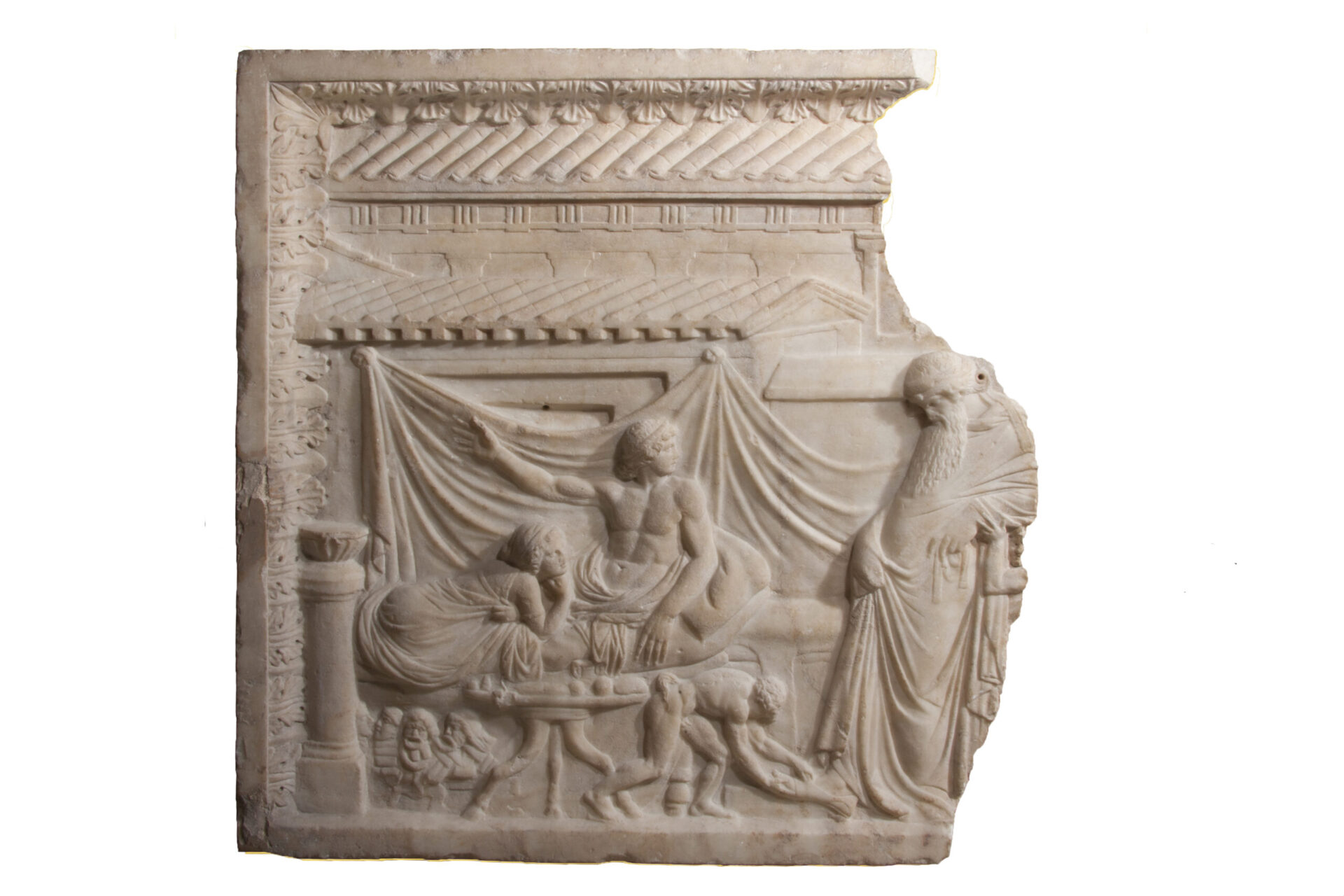Exhibit of the month
Ecstatic drunkenness
Marble relief of Dionysos
National Archaeological Museum
Sculpture Collection, inv. no. Γ 5147
Provenance: From a private collection (donated by Louisa Straight).
Dimensions: Height 86 cm, preserved length 81 cm.
Date: Early 1st century AD.
Display location: Room 31.
The relief, adorned with an integral elaborate frame, has the form of a panel and was meant to be embedded in an architectural structure, possibly of a public building. It has a decorative character. The relief depicts, on the left, a reclining, wreathed young man, in the type of the banqueting hero, raising his right hand in a gesture of greeting and turning his head towards the god proceeding from the right. His consort is prone before him, also turning her head towards the visitor. In front of the couple of banqueters is placed a table filled with a variety of viands and a bit lower a shelf bearing papyrus rolls and theater masks, denoting the banqueter’s identification as a poet. His status is also confirmed by the majestic figure of Dionysos in the type of Dionysos-Sardanapalos, approaching from the right.
The god, lowering his head, under the influence of wine, is supported by a young Satyr [1], whose only the arm is preserved, and is raising his right foot, so that the leading Satyr can take off his sandal, enabling him to lay on the empty couch behind him. The scene takes place in the atrium of a private house, in front of a rich curtain, separating the divine epiphany from the urban environment at the background.
The reconstruction of the relief is based on the best preserved counterparts, housed in museums abroad (the Louvre, British Museum, Archaeological Museum of Naples): on the right the entourage of Dionysos is depicted, comprising four dancing Satyrs and a young Maenad. This type of representation constitutes an innovative creation of a “Neo-Attic” workshop at ca. 100 BC and combines the classical heroic banquet with the visit of the god and his thiasos, so as to create the Theoxenia of Dionysos by a mortal, a “mousikos aner”. The theme had at first been interpreted according to Roman literary works. However, the identification as Ikarionreliefs has prevailed, based on the mythological version of Dionysos’ visit to the shrine of the attic hero Ikarios at mount Dionysos. Ikarios, along with his daughter Erigone, hospitably received Dionysos, who in turn taught them viticulture and wine making.
Dionysos, the son of Zeus and Semele, was the god of nature, vegetation, viticulture and wine, of Maenads, ecstatic dance and theatre. Under the influence of wine his entourage praises him in an orgiastic manner in a frenzy of excitement beyond any reason, while men cite him in sympotic banquets. The shared enjoyment of wine in symposia offers relaxation and high spirits. According to Plato[2], wine drinking releases banqueters from their scruples and urges them to temporarily surpass their limits. This mood is also characteristic of the merry band of revellers of our relief, who are depicted in a komos scene, staggering drunkenly from a symposium and leading to another, supporting each other, dancing in ecstatic poses and erotic mood and holding musical instruments in their hands.
[1] Sarcophagus depicting a drunken Dionysos, supported by a Satyr and flanked by pairs of Erotes https://www.namuseum.gr/en/monthly_artefact/naughty-erotes/
[2] Symposium 223b.
Dr Chrysanthi Tsouli
Bibliography
Β. Hunsdaltz, Das sogennante dionysische Schmuckrelief, München 1987, no. Κ 28.
Ε. Polito, Luoghi del mito a Roma. Ambientanzione urbana in alcuni rilieve paesistici, RivIstArch III, 17, 1994, 83.
Ι. Mennenga, Το διονυσιακό ανάγλυφο αρ. 5147 στο Εθνικό Αρχαιολογικό Μουσείο, ένα νέο έκθεμα, Το Μουσεῖον 7, 2009-2013 (2017), 67-78.
Selected bibliography on Dionysiac reliefs
C. Watzinger, Theoxenia des Dionysos, RM 61-62, 1946-1948, 76-87.
Ε. Pochmarski, Dionysische Gruppen. Eine typologische Untersuchung zur Gesichte des Stützmotivs, Wien 1990.
Fr. Sinn, Beobachtungen zur Entwiclung der Römischen Ausstatungkunst, Ostraka IX.2, 2009, 385-418.
A. Heinemann, Ein dekorativer God? Bilder für Dionysos zwischen griechischer Votivpraxis und römischem Decorum, στο R. Schlesier (επιμ.), A different God? Dionysos and Ancient Polytheism, Berlin 2011, 391-412.


